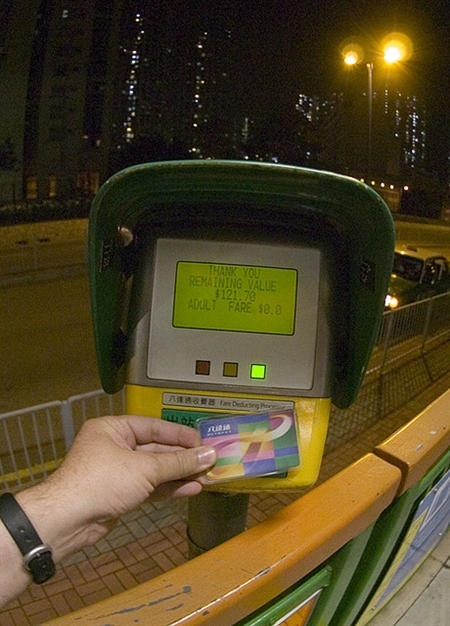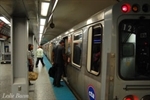
|
New York City commuters can pay subway and bus fares with a tap of their Smartphone. |

Hong Kong's Octopus transit smartcard works throughout the city's various transit systems, and can even be used to pay at convenience stores.
Photo by Chris Humphrey
Improving transportation infrastructure means more than building roads and bridges. Intelligent Transportation Systems (ITS) use technology to maximize the capacity of existing highway and transit infrastructure to improve traffic flow, decrease delays, and give riders up–to-the-minute system information for a relatively low cost. At a 9:1 cost benefit ratio, ITS have a greater return when compared to traditional transportation projects, which have a benefit-cost ratio of 2.7:1. The Chicago region has dabbled in ITS with the Chicago Transit Authority’s (CTA) bus and train trackers that make transit more convenient for riders, and the Illinois Tollway’s I-PASS electronic tolling system, which improves congestion and saves time for Tollway drivers. Still, there is tremendous room for growth. Cities around the world are proving the real potential of ITS by implementing such technologies as congestion pricing, variable priced parking, and universal fare cards.
Congestion pricing is an effective ITS tool to reduce traffic gridlock, improve the environment, and expand transportation choices to meet people’s needs. Congestion pricing gives people options: to pay a fee to drive on a traffic-free road, to travel on an alternative route, or to take transit. Minneapolis' congestion pricing program MnPass has been so successful in reducing congestion that the Minnesota Dept. of Transportation recently committed $17.6 million to extend the project. In Chicagoland, following the Metropolitan Planning Council (MPC) and Illinois Tollway’s July 2010 report The Road Less Traveled: Exploring Congestion Pricing in Chicagoland, the Tollway was awarded federal funding to study the integration of transit with managed lanes on I-90.
Variable priced parking is another ITS tool to alleviate congestion by varying parking meter rates based on time of day and location, to manage demand for existing parking so that drivers do not have to circle to find parking or double-park, reducing congestion and improving air quality. In San Francisco, SFpark is a variably priced, federally funded pilot program that periodically adjusts meter and garage pricing to match demand, and collects and distributes real-time information about where parking is available so drivers can quickly find open spaces. Parking information is available to the public via a Smartphone application (and eventually text messaging) to help drivers find parking with greater ease and convenience.
ITS also makes transit more efficient and convenient for riders. Universal fare cards allow transit consumers to use multiple modes without paying for multiple tickets. Hong Kong’s Octopus transit smartcard first employed universal system technology (you can even use it to pay for snacks at convenience stores) in 1997. In 1999, Berlin’s regional transportation authority implemented a unified fare card system, through which fares are collected by the regional agency and then redistributed to operating agencies based on monthly ridership. Even cooler: New York City residents can pay for transit with the tap of a Smartphone, as can the Chinese, because both have moved toward payment systems that deduct funds from the SIM card of a cell phone.
Chicago will soon be added to this list. On July 7, 2011, Ill. Gov. Pat Quinn signed HB 3597, a bill for “21st Century transit reform” that requires the Regional Transportation Authority (RTA) to develop a universal fare card for use on all bus and rail services provided by the CTA, Metra and Pace by Jan. 1, 2015. And, get your laptops ready: By the start of 2012, the RTA must submit a feasibility study for wireless internet service on all buses and trains.
As we grapple to find solutions to our transportation problems and do more with less money, ITS is a lower cost answer to squeeze capacity out of the existing system without requiring major infrastructure investments. The region’s success with transit trackers and I-PASS proves implementing technologies such as congestion pricing, dynamic traffic signals for pedestrians, variable priced parking, and transit signal priority for buses (so red lights turn green as buses approach an intersection) will make a significant improvement in Chicagoland’s transportation system for minimal cost.
News
Local
Parking solutions don’t have to be taxing
Before rushing ahead with a weekday parking tax proposed last week for the downtown area, Chicago officials should closely study a new experiment on the West Coast, experts say.
Quinn appoints Illinois transportation secretary
Pat Quinn has appointed a new leader for the Illinois Department of Transportation. Quinn on Monday named Ann Schneider to be secretary of the state transportation department. Schneider has been acting secretary since July.
Illinois, Zipcar launch transportation program for state employees
Illinois' Department of Central Management Services and Zipcar Inc. announced a new initiative allowing state employees to use Zipcar's vehicles for state business travel.
Tollway is Looking for the Next Cutting-Edge Way of Doing Business Just as the latest smartphone is replaced with better technology, so can a tollway’s electronic tolling system. The Illinois Tollway’s I-PASS system has been around for nearly a decade, and tollway officials say it is time to expand and update its capabilities.
CTA lays off three media staffers in further front-office pruning The CTA on Tuesday let go its general manager of public affairs, manager of media relations and a spokeswoman, said Molly Sullivan, vice president of communications and marketing. The downsizing leaves four employees working in media relations under Sullivan.
National
SQLstream Debuts Down Under With Real-Time Intelligent Transportation SQLstream Inc. today announced the public availability of SQLstream ITS Insight, the first real-time solution for reducing congestion to exploit low cost wireless GPS data as a complement to existing fixed-road sensor investment.
With Congress in limbo, Michigan Governor Rick Snyder puts promising transportation ideas on the table
State and local officials are coming to grips with the fact that they cannot wait for Washington act on infrastructure investment and repair. Michigan Governor Rick Snyder (pictured at right), a Republican elected in 2010, is one of those leaders. And his new $1 billion blueprint for the state’s infrastructure, released earlier this week, does a commendable job of ditching ideological gestures in favor of common sense.
Bus Rapid Transit plan for the Detroit metropolitan area unveiled Gov. Rick Snyder today will announce plans for a 110-mile network of sleek rapid transit buses in metro Detroit, operating within two or three years, that will move people as fast and conveniently as light rail.
The Power of Blogs and Social Media in Transportation Policy
Bike Portland was the first to call out GM. The League of American Bicyclists followed suit. Tweets started pouring in from all over the country. The next day — boom — GM promised to pull the ad and issued an apology.
New Transportation Taxes, Fees Head To Lawmakers
Proposed taxes and fees aimed at raising more than $800 million in new transportation revenue annually in Maryland headed toward the Legislature and Gov. Martin O'Malley on Tuesday, as a state commission formally approved a plan to increase the state's gas tax by 15 cents over three years.
Dems introduce bill creating Obama's infrastructure bank
House and Senate Democrats have introduced legislation that would establish a National Infrastructure Bank, similar to what President Obama has proposed in his jobs plan.
Global
Ghana launches national policy on public-private partnership
Mr. Fiifi Kwetey, a Deputy Minister of Finance and Economic Planning, on Tuesday said the government would continue to create an enabling environment for private sector participation so as to close the country’s infrastructure gap.
The Daily Dig: New $5.50 ‘Canadian Tax’ Imposed on Travelers
The U.S. has announced that any Canadian traveling to the country by air or boat will be charged a $5.50 tax.
Spending on Infrastructure in Qatar to Reach $ 150 billion in 5 Years
The Minister of Economy and Finance said spending on non-oil related infrastructure in Qatar will reach $150 billion over the next five years.
Govt to give tax breaks for infrastructure
The federal government is set to offer tax breaks for private-sector investment in infrastructure projects to boost Australia's production of goods and services.
Lima’s Metropolitano BRT Celebrates 100 Millionth Passenger The Metropolitano System of Transport, more commonly known as Metropolitano, in October completed one year of full operation. The Metropolitano Bus Rapid Transit (BRT) Segregated Corridor of High Capacity (known as COSAC I, by its Spanish acronym) reached its 100 millionth passenger mark.
 | ||||
Talking Transit is sponsored by  | ||||
Upcoming events
In Chicagoland? Take two minutes and sign up today to join Riders for Better Transit, a voice for riders who want to boost transit funding and encourage transit-related projects that will benefit your communities and our entire region.
|
||||
|
Tell us what you think of Talking Transit. Email talkingtransit@metroplanning.org with feedback in the subject. To subscribe, visit our website at metroplanning.org/signup.html. |
Email design by Webitects
Metropolitan Planning Council | 140 S Dearborn St | Suite 1400 | Chicago, IL 60603Phone (312) 922-5616 phone | (312) 922-5619 fax | talkingtransit@metroplanning.org
Copyright © 2025 Metropolitan Planning Council. All rights reserved.
To stop receiving this newsletter visit metroplanning.org/unsubscribe.html?EmailMsgId=147&email=

